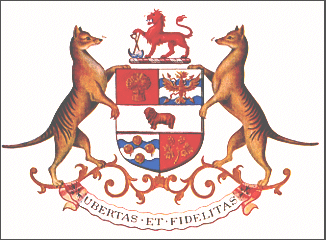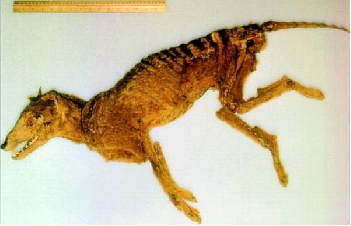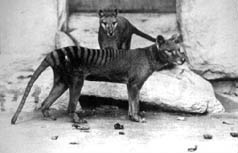Mysterious Marsupials
Pouched predators unknown to science
Thylacine
Of all carnivorous cryptids, and perhaps even cryptids in general, the thylacine is no doubt the one of the best-known. It has had dozens of books written on it, television programs about it, and websites dedicated to it. It is the symbol of the Center of Fortean Zoology, and even the main chat room at cryptozoology.com is named after it! The reason behind its popularity is unknown; possibly it has something to do with the numbers of sightings, or maybe because the animal truly did exist once, or maybe it is simply a fascinating animal. Whatever the reason, the thylacine is one cryptid here to stay.
The thylacine, a sientifically acknowleged and a once living animal, is also reffered to as the Tasmanian wolf, Tasmanian tiger, marsupial wolf and marsupial tiger, though it is in fact no way related to either wolf nor tiger, other than general appearance. It is, as the latter nicknames suggest, a marsupial, with kangaroos and kolas as closer relatives than canids and felids. The animal is a dasyurid, in the family Dasyuridea, a member of the same family as Australian quolls, ‘native cats’, and (it’s closest living relative) the undersized and less formidable ‘Tasmanian devil’. Its Latin name, Thylacinus cynocephalus, translates to mean ‘pouched dog, dog-headed’ respectively, referring to it’s dog like form. The animal resembles a tawny shorthaired dog with a long, stiff tail and rounded ears, and a row of darker brown stripes starting midway along the back and extending to the tail. During the Pleistocene the thylacine was found on Australia’s mainland in a variety of subspecies, and was among the continents top predators. About 12,000 years ago, the thylacine disappeared from the mainland, either just another victim of climatic change, or due to competition from more efficient dingoes, half-wild dogs introduced by colonizing Indonesians. Whatever the reason for the animal’s disappearance, neither dingoes nor theoretical climate changes reached the island of Tasmania, where the animal survived until the arrival of modern European Australians. The thylacine was almost immediately seen as a threat to the newly introduced sheep – the livelihood of most colonists – and both government and private campaigns spearheaded the animal’s destruction. Bounties were offered for ‘tiger’ scalps, and the increasing expansion of civilization drove the remaining thylacines farther and farther into the wilderness. An epidemic of distemper probably sealed the animals supposed fate; by the start of the 20th century they were already extreamly rare. The last bounty was paid for a skin in 1909, and he last thylacine was shot was in 1930. The last specimen known to have ever existed was caught in western Tasmainia in 1933. The thylacine, nicknamed “Benjamin”, lived in the zoo for three years, dying September 7th, 1936; only two moths after the Tasmanian goverment had passed a law protecting the animal.
The official Tasmanian coat-of arms, depicting two thylacines.

The true mystery of the thylacine starts almost immediately after the animal’s extinction. By the time of Benjamin’s death, most Tasmanians had begun to feel more sympathetic toward the thylacine. Later, as the dislike of the animal faded, the Tasmanian coat-of-arms would depict a pair of thylacines, and the animal would almost become the provincial symbol. Only a year after the death of Benjamin, the Australia’s Animals and Birds protection Board sent a pair of investigators to the remote mountains of northwestern Tasmania to look for other survivors. Though no definite evidence was ever found, the researchers did collect a handful of sightings from residents of the area. The sightings, while inconclusive at best, were enough to prompt further investigation by the board. A 1938 team found the first hard evidence – thylacine spoor, bearing the thylacine’s distinctive five-toed front foot and four-toed hind foot tracks. Unfortunately, the Second World War stalled later investigations of the cryptid, the next expedition was not until a private one in 1948. Tracks were found and sightings were collected, but no real evidence was found. Eric E. Guiler, a chairman from the Animal and Bird protection Board, mounted nine expeditions between 1957 and 1966, after finding sheep kills and tracks unmistakably like those of the thylacine. He was able to amass more evidence, but failed to either find a body or have a sighting himself. Camera-trap operations had similar failure. A NPWS park ranger made a much-publicized sighting from the back of his pickup truck in 1982, seeing the animal in a spotlight from twenty feet. The NPWS made an announcement to discourage people from trying to find the animal, lest they threaten or disturb it. While the announcement was not interpreted as the official return of the animal, some have said it shows government recognition, whether officials admit it or not. Investigations of the animals presence continue to this day, but skeptics remain unconvinced, attributing sightings to misidentifications of dogs and devils, and kills as caused by the same. Still, every year people report tawny, brown, or even grey striped doglike creature with greyhound-like muzzle in the remote forests of northern Tasmania. The mystery of the thylacine, however, does not end at provincial borders.
In 1981 a number of unusual sightings in the southwest corner of Western Australia prompted the Agricultural Protection Board to send Aboriginal tracker Kevin Cameron to investigate. The animal, which Kevin soon saw for himself, was quickly identified as the, much to the shock of the board, a thylacine. This report also came as quite a surprise to the rest of the world, as even those who found the possibility of thylacines living on Tasmania found it difficult to believe they could have lived, unnoticed, in Australia for the past 12,000 years. Prior to the sightings, there have been no fossils, legends, or records from either aborigines or settlers through the early nineteenth century to suggest they lived there. The earliest account of thylacines on the mainland comes from 1951, when a man from Dwellingup showed up at the Western Australian Museum with photos and casts of tracks he asserted were produced by a thylacine, even claiming a personal sighting. Zoologist Athol M. Douglas, who met the man at the museum, rejected his claims immediately. Several years later, the same zoologist killed a creature responsible for some strange sheep deaths – and found it to be nothing more than a feral afghan hound. Even though this reinforced his skepticism, he admitted to, over the years, finding several kills of animals that had been killed in the manner that thylacines, not dingoes, kill their prey.
Much later, in 1985, when Douglas was given five color photos of a thylacine by Cameron, his doubts all but evaporated. The photos showed what looked like a thylacine burrowing at the base of a tree, with clearly defined stripes and a long, stiff tail. Though Cameron would not tell Douglas where he had taken the pictures, he did produce plaster-casts of prints. While most of Cameron’s descriptions rang true to how thylacines were described, stranger still since Cameron was described as barley literate, his secretive behavior suggested something amiss. Later, when submitting the photos for a article of New Scientist, Douglas noted that the film had been cut, and that the photos had been taken at different angles, and even the shadows seemed to move, not matching Cameron’s account of what happened. Also, in one of the negatives, there was a shadow of what looked to Douglas like a shotgun pointed at the animal. To skeptics, this meant Cameron had simply and leisurely photographed a model of a thylacine, and had sloppily allowed the shadow of some equipment into the frame. Douglas, however, found the model too realistic and the gun like-shadow too suspicious to accept that explanation. He though it more likely that Cameron and an unknown friend found the thylacine digging at the base of a tree, photographed it, shot it, and photographed the body, stiff from rigor mortis, over the next hour or so. Since anyone who is convicted of killing a thylacine is subject to a $5,000 fine, Douglas put this forward as the suggested reason for Cameron’s secrecy.
In 1966 a mummified thylacine, found by the Western Australian Museum in a cave near Mundrabilla Station, was found in such well-preserved condition (even the stripes were visible) that it appeared to have died no more than a year ago. Unfortunatley, the specimen was carbon-dated to have been 4,500 years of age – much older than expected, but putting the thylacine’s mainland extinction at half as long ago as previously thought. About twenty years later a similar expedition to the same cave found a new carcass – that of a dingo – that was hairless and had parchment-like skin. Though the dingo could not have been in the cave for more than twenty years, it was in a far worse state of preservation than the thylacine. Some have suggested that the thylacine was in fact even more recent than dated - as supported by the dingo – and that groundwater contamination had caused inaccurate dating. In addition, in 1974, a thylacine shoulder bone – though to delicate to date in it’s own right, was found among the bones of small animals dated to be no more than eighty years old.
Eastern Australia, particularly the areas north of Queensland, has had a smattering of sightings of striped, doglike animals, usually from the remote mountain regions. Many, including cryptozoologist Rex Gilroy, have them at close range, usually at night from a spotlight or the headlights of a car. Print casts and consistent descriptions reinforce the animals supposed presence. Some supposed thylacines, due to there livestock predations, have acquired local nicknames. In south Victoria, for example, the “Wonthaggi monster’ was reputed as responsible for numerous sheep deaths. When up close sightings were made – rarely – the animal was described as having a thick, tapering tail, light-grey in coloration, and having dark stripes along it back, boldest at the hindquarters. This, of course, almost exactly matches the thylacine. The “Tantanoola Tiger “ and “Ozenkadnook tiger” reported from along the Victoria/South Australia border are practically the same animal. A fairly good photo, though possibly a hoax, was taken in Victoria in 1964, showing a thylacine walking through thick foliage.
A mummified thylacine found in a cave in Western Australia.

Western New Guinea has also had a collection of reports and livestock killings has suggested its survival there to. While it is said to have been extinct in that region for over 2,000 years, those who investigate reports of such animals deem them credible.
Queensland tiger
Though rarely sighted today, the Queensland tiger is Australia’s answer to local mystery cats. Also known as the Yarri or striped marsupial cat, the animals description varies from a cat-headed thylacine to a half-grown tiger, but always that of a round-faced dingo-sized carnivore. The earliest described sighting is from 1705, from Batavia, describing an animal with 18” at the shoulder, with a catlike face and stripes from the small of its back to the end of its tail, as does the thylacine. One report from Queensland from the same time period describes a round-faced yellow animal with black stripes and a long tail. The account describes the animal as being tracked and flushed out of tall grass by a dog, and then being chased up a tree, before racing back down again at the dog. As thylacine cannot climb trees, even dubious mainland ones, we can discount it as a suspect in this case. Norwegian zoologist Carl Lumholtz in the 1800’s recorded, from local aborigines, an animal like a dingo, but with shorter legs and with bands encircling its entire body. Reportedly, it could climb trees and lived in rocky areas. Early in the 1900’s, George Sharp describes seeing an animal that was “larger and darker” than the thylacine, with distinct stripes. One was shot by a farmer when attacking his goats, after which Sharp found a body, half eaten by pigs, and judged it to be about five feet long. Sadly, though, he had no means of preserving the remains. Ion L. Idriess of York peninsula once saw one disembowel an adult kangaroo along the Alice River. In a separate encounter, he found the body of one that had been killed fighting with a staghound, which lay nearby. The animal was described as the size of a hefty mid-sized dog, striped in black and grey, and with feet armed with lance-like claws “of great tearing strength”. The animal had pointed pricked ears and a tiger-shaped head. One was found eating a dead calf between Munna creek and Tiaro in 1930 by G de Touroeur and P B Scougall. It was described as ‘nearly the size of a mastiff, of a dirty fawn color, with a whitish belly, and broad blackish stripes.” The animal’s head was round with prominent “lynx-like” ears and a tail that reached to the ground, with large pads. A few stones tossed at the animal caused it to crouch low and issue a “raspy” snarl, similar to that of a leopard. They eventually chased it off with stock whips. A 1982 report described the animal as having a round, broad head and teeth that protruded like tusks. More recent reports are somewhat lacking, but still present. In 1982, a leopard-sized animal with a catlike gait and a striped tail was seen near Perth. In 1984, a panther-sized striped animal was seen eating a sheep while perched in a tree. A hunter in 1987 near Hughenden saw a large ‘hay-colored’ animal with black body stripes attack and eat a dingo the hunter had wounded and was pursuing. The most recent significant sighting was a body found in mid-September 1995 along the Bruce Highway, twelve and a half miles from Cardwell. It was the size of a small cattle dog, female, with a catlike face, short pointed ears, and with distinct stripes near the chest. The stripes were spaced on a dark tan background, and the tail had a tiny, whit tip. The remains were regarded as to mangled to make a positive identification. The Ozenkadnook tiger, though more often though of as a thylacine, is occasionally described with markings similar to the Queensalnd tiger. New Guinea striped beasts are also sometimes described as having a catlike head. Reports of black panthers and pumas are typically classed as ABC’s (see Phantom Felids).
Only one real (if only formerly) animal matches the description of the Queensland tiger; the extinct Pleistocene era Thylacoleo. Though there are though to be several species of Thylacoleo, including crassidentatus and hilli, though only Thylacoleo carnifex, the largest and most widespread species, is though of as a possible candidate. Also called the marsupial lion, T. carnifex was a carnivorous member of the order Diprotodonta, which it shares with wombats, koalas and kangaroos. The animal certainly resembles the Queensland tiger in most of the obvious aspects; the catlike head is most apparent. The long digits and oversized heavily clawed paws are found both in fossils and in modern descriptions, as are the aboreal habits in which such paws are used. The size is also a match, as thylacoleo was about the size of a leopard, and also had a large heavy head with a muscular neck, both which seem to fit most reports. Even the rare report of protruding teeth seems to match, as thylacoleo had enlarged incisors to act as canines (the true canines were reduced to stubs). Teeth positioned like that very well may have protruded from the mouth under some circumstances. Even the ears are shown as small a set back in thylacoleo reconstructions. The only really discrepancy is that thylacoleo had proportionately long limbs for its size, while some reports of the tiger describe rather short legs. Possibly this is due to comparing the tiger to animals with long thin legs, such as the dingo.
A reconstruction of the extinct Thylacoleo.

Phantom Felids
Cryptic Canids
Mystifying Mustelids
Unknown Ursids
News
Main Page
Email: ehtouzjian@direcway.com



